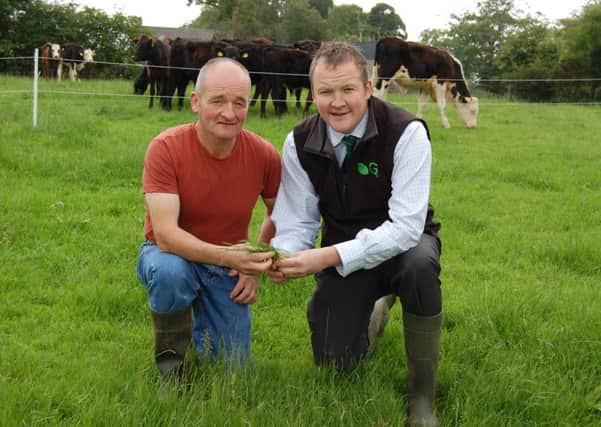Strategic re-seeding helps boost grass output


The Keady man farms 210 acres: 80 at home and an additional 130 acres on a nearby out farm. He manages a herd of 40 suckler cows, buys in additional stores and operates an Angus certified calf to beef system with a tie in to Linden Foods. All the cattle reared on the farm are brought through to beef.
Nugent confirmed that grazed grass is the cheapest feed that can be offered to stock, adding:
Advertisement
Advertisement
“So it makes sense to make best use of this resource. Ground that was re-seeded in September 2014 is currently carrying 52 weanlings that are destined for the Angus scheme. The grazing area has been divided up into paddocks and the cattle weighed regularly.
“I estimate that I am getting a third more liveweight gain from this land than would have been the case previously. In the past all the cattle on the farm would have been set-stocked.”
Nugent is targeting a 21-day rotation period with the cattle.
“And we are achieving this,” he said.
“A key benefit of re-seeding is the significantly improved recovery time of swards. It’s simply a case of topping and spreading a small amount of fertiliser on each paddock as soon as it is grazed out.
Advertisement
Advertisement
“Making sure the cattle have access to plenty of water at all times is also important. With this in mind, I run an above ground water pipe, which is mains fed, through to a portable plastic drinking trough. This can then be moved from paddock to paddock with the cattle.”
Nugent believes that a commitment to re-seeding forces farmers to fundamentally think about the significance of soil quality and the impact this factor has on grassland output.
“The first step in the re-seeding process is to have the land soil tested,” he said.
“In my case the process threw up a range of results, where soil pH was concerned. This had implications for the liming programme that followed.
Advertisement
Advertisement
“I can genuinely see the benefits that re-seeding has brought, in terms of improved grassland output and stock performance. It’s now a case of re-seeding the entire grassland area on the farm over the coming years.”
Nugent has also re-seeded a proportion of his silage ground. And, here too, the improvement in grass output levels has been significant.
“And I have not changed the fertiliser programme used on the farm in order to achieve this boost in performance,” he stressed.
Germinal NI’s David Little was a recent visitor to the Nugent farm. He said that less than 3% of Northern Ireland’s grassland area is re-seeded every year.
Advertisement
Advertisement
“In reality, this figure should be up at 10%, if farmers want to fully avail of the benefits they can secure from planting out new, genetically improved grass varieties.
“The scope to increase output from grassland here in Northern Ireland is immense. And a commitment to re-seeding with recommended varieties will be part of this improvement process.”
Little was quick to counter the suggestion that re-seeded swards are extremely open and prone to poaching.
“The trick is to establish new swards with the right balance of diploid and tetraploid varieties,” he stressed.
Advertisement
Advertisement
“In this way, a thick canopy of grass is established from the outset.
“In most years, the August: September period offers a strong window of opportunity within which to re-seed land, especially from a feed budget perspective.”